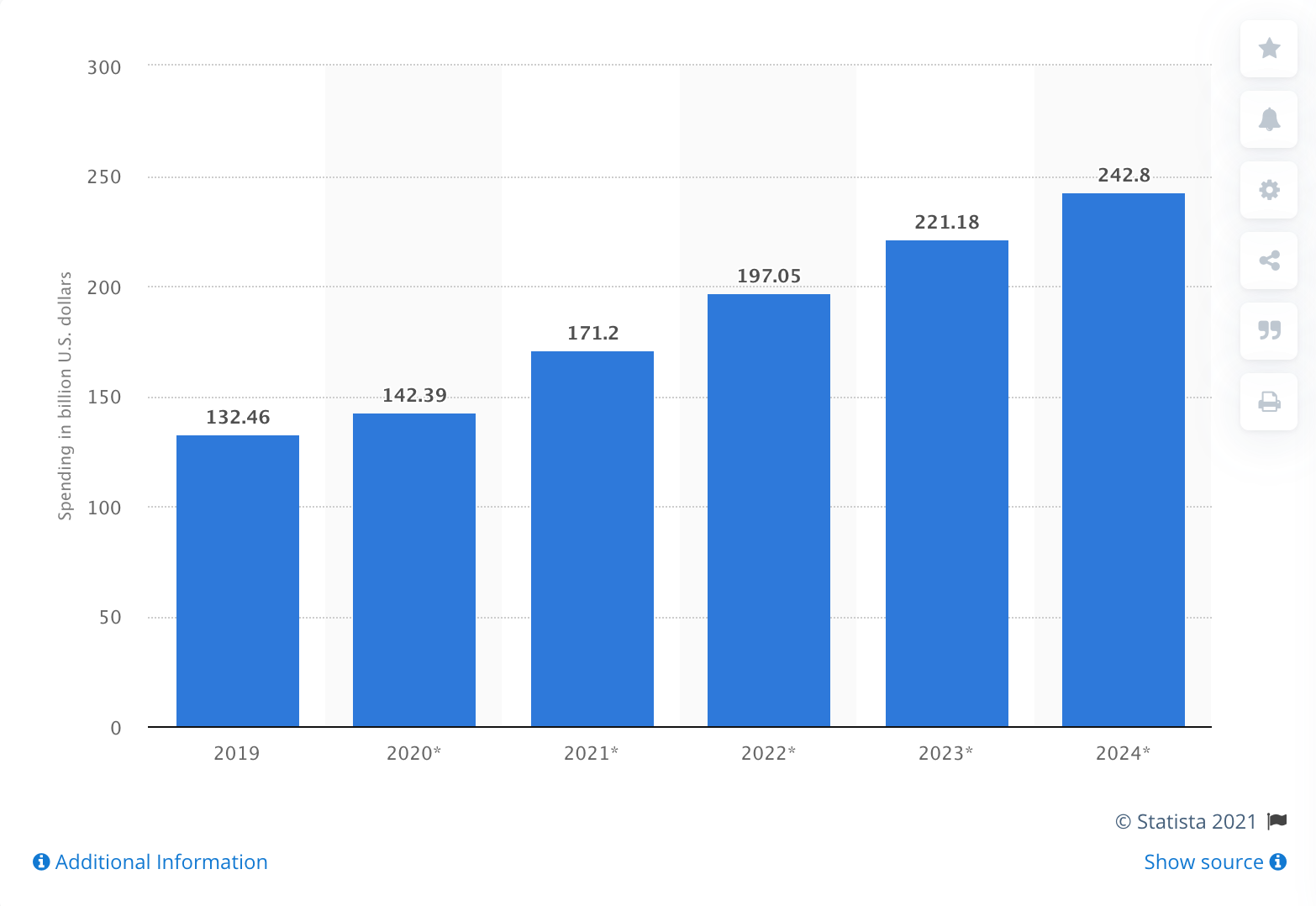After nearly two decades of the internet being essentially a wild west of user information, governments are now cracking down on tech giants for the power they have over user information and behavior.
You’ve likely been hearing words or acronyms like GDPR, CCP, and iOS 14 since at least 2019.
Each of these is some form of regulation or update that’s causing user data to be better protected — which sounds great, right?
For us advertisers, it’s actually a downside. No matter what you think online privacy should look like, there’s no arguing that lax rules over the last 20 years have largely contributed to digital advertising becoming such a large part of many companies’ media mixes.
 Digital advertising spending in the United States from 2019 to 2024 (in billion U.S. dollars)
Digital advertising spending in the United States from 2019 to 2024 (in billion U.S. dollars)Without much in the way of restrictions, we’ve been able to advertise to users based on nearly all of their online activity and personas. It’s been a boon for digital marketers.
But these updates are causing us to take a step back and rethink what we’re doing. Some targeting options are going away while others are only changing (usually to be less specific).
Tracking options are also being impacted. Even if some of your favorite targeting options aren’t going away, you likely won’t be able to track future efforts with as much accuracy.
With all of these changes, you might be asking…
What Can Advertisers Do?
While the tech companies like Facebook fight to get these restrictions minimized, one answer to this challenge is for companies to work on building their own data sets so we’re not as reliant on these companies.
The idea here is to leverage data points customers willingly provide to you rather than those they don’t realize they’ve shared.
Sounds great, right?
Potential future customers simply sign up to be a part of your marketing list.
Odds are you’ve probably already gotten the rub: who wants to opt into a marketing list?
Answer: almost no one.
But that doesn’t mean it’s impossible. Although building a first-party data set isn’t the only way around these privacy issues, I think it’s a great option for a number of reasons:
- The users you end up with on this list should be highly qualified.
- It provides companies an opportunity to be helpful to their customers, not just shoving sales messaging in their faces.
- It’s more forthcoming than some of the tactics we use now.
With all of that said, let’s get into it. How can you start building your own first-party data sets?
1. Know Where to Find Your Audience
The first challenge, as with any other campaign, is to know where to find your target audience.
- What types of targeting options do you need to use to find your customers?
- Where do they spend their time online?
- What types of user experience do you need to curate?
Think of all the targeting options available and craft top-of-funnel strategies within the ad platforms to reach those users.
For example, if you’re trying to reach marketing managers within a certain industry, LinkedIn is likely going to be the best bet given their B2B capabilities.
If you’re attempting to reach people looking to redecorate their house, you’re likely better off with Instagram and Pinterest.
Younger users are going to spend far more time on TikTok and Snapchat than they are Facebook.
Be sure you’re not only focusing on the right targeting options, but channels as well since they all have different compositions.
2. Offer Something of Value
Everyone knows when you send a company your name and email, you’re signing up to have that information used in one way, shape, or form, which is never really appealing.
So the biggest challenge to advertisers is to offer something valuable enough that people will opt into your marketing for it. Think about some of these questions when trying to determine what you should offer your customers:
- What is it that my customers really want?
- What are the current problems that they’re facing?
- What are some common questions we get through support/chat that we can answer preemptively?
- What upcoming events are our customers preparing and planning for?
- How can our knowledge/expertise help our customers without sacrificing our bottom line?
Once you have an idea of these priorities, you can start to think of formatting. Would it make a good infographic, audiobook, downloadable guide, calendar, or something else?
It doesn’t have to be too complicated. Find the most succinct format and package it so your customers can learn from you.
There a number of different calls to action you can use to entice your customers and provide value to them beyond the end sale.
3. Price Your Item of Value Appropriately
When testing the calls to action listed above, make sure you’re not being unreasonable about what you’re asking from the user.
In lead generation, there’s a non-monetary price someone pays when they fill out a form. It has three components:
- Time.
- Attention.
- Information.
The more time, attention, information, and/or combination thereof that you ask a user to give up, the higher the price of that lead.
When you’re creating your first-party data collection campaign, think about how much of each of these you’re asking the user when they are trying to engage with your valuable offer.
For example, let’s say you’re offering a free ebook download. It doesn’t make sense for you to ask for the person’s credit card information to get the ebook since it’s free.
Sure you want that information eventually, but this is not the avenue to do that.
The same thing goes for most other calls to action. Be sure you’re asking for an appropriate amount of information rather than simply trying to squeeze every last drop out of that lemon.
The biggest takeaway here is that we want to eventually be able to upload these lists to the ad platforms to target them. Most platforms only allow for name, email, phone, city, zip, and sometimes a couple of other pieces of info.
So make sure to craft your CTAs well enough to get those pieces of info, but save the rest until you’re creating your bottom-of-funnel campaigns.
4. Follow Through on Your Top of Funnel Leads
The absolute worst thing you could do after reading this blog post is put together a first-party data generation campaign, generate a number of leads, and then never do anything with them.
CRMs are a highly valuable asset for this strategy as they help you curate lists of users, manage their information, and track how they are progressing through your pipeline to becoming customers.
Take the time to build lists of users in your CRM and then target them through your ad campaigns. These can be manually imported or direct imports if the channel and your CRM have a native integration.
Since the users are familiar with your company and you’ve (hopefully) provided value to them in the past, they should be more likely to convert the next time around.
Continue focusing your calls to action on the user’s journey and what information they would need to eventually make a purchase from you.
Maybe they have everything they need after that first touchpoint. Maybe they need months of nurturing to get there.
Either way, don’t squander this valuable list.
More Resources:
- 5 Ways to Improve Your Lead Gen Campaigns Throughout the Funnel
- 4 Things to Do When Your PPC Campaign Isn’t Generating Leads
- The Biggest PPC Trends of 2021, According to 32 Experts
Image Credit
In-post image: Statista.com





